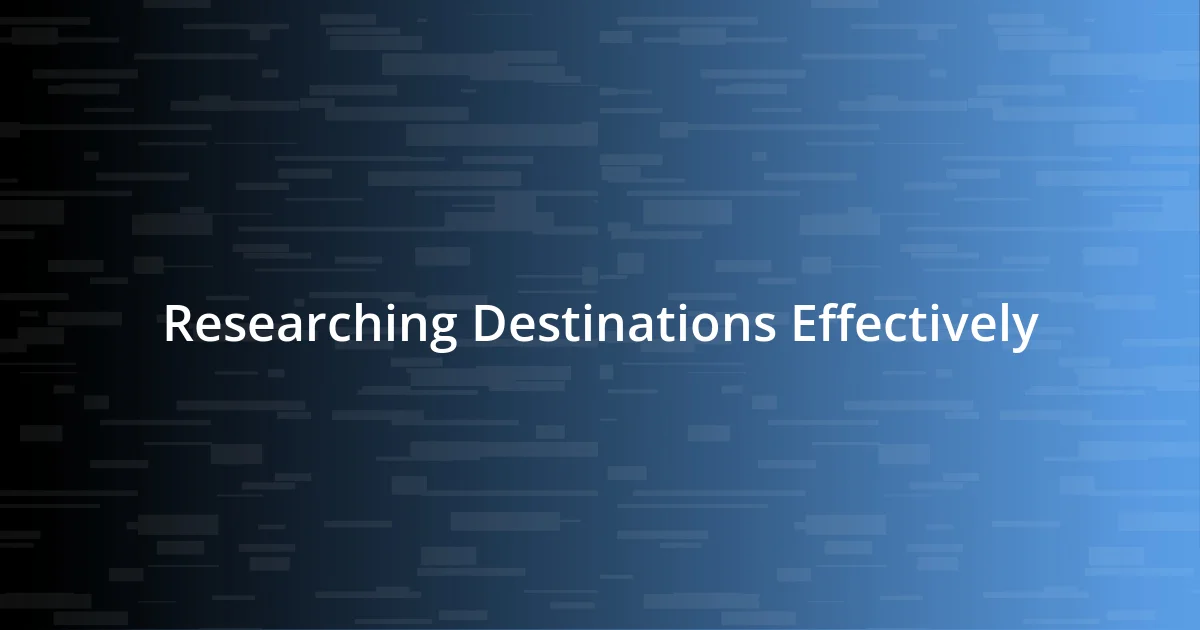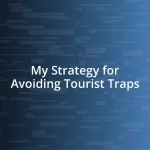Key takeaways:
- Understanding travel goals can evolve through experiences, emphasizing the importance of flexibility and spontaneity in creating memorable journeys.
- Researching destinations effectively involves utilizing diverse sources, engaging with locals, and visualizing the experience to enrich travel plans.
- Adjusting plans on the go often leads to unexpected, rewarding moments that enhance the travel experience, underscoring the value of adaptability.

Understanding Travel Goals
Understanding your travel goals is like mapping out a treasure hunt; it sets the course for an adventure that’s uniquely yours. When I planned my first solo trip, I was driven by a desire for self-discovery. But as I explored the vibrant streets of Barcelona, I realized that my goal shifted – it became about connecting with locals and savoring each moment.
Have you ever felt lost amidst a whirlwind of travel options? I certainly have. It can be overwhelming to choose between relaxation and adventure. Reflecting on what truly excites us helps clarify these goals. For instance, realizing that I craved a blend of relaxation and exploration influenced my choice of destination, leading me to Thailand’s serene beaches coupled with rich cultural experiences.
Your travel goals can also evolve over time. I remember planning a family trip and anticipating stress, but instead, we shared laughter while navigating theme parks. This joy transformed our travels into lifelong memories, reminding me that understanding our goals often involves embracing the spontaneity of experiences. What might surprise you in your next trip?

Researching Destinations Effectively
When it comes to researching destinations effectively, the process can feel like peeling back layers of an onion—each layer reveals something new about the place I intend to visit. I often start with online forums and travel blogs, where personal experiences breathe life into the details that mere statistics can’t convey. For example, reading about someone’s unexpected encounter with a street performer in Paris added a layer of excitement to my itinerary that I hadn’t considered before.
Here are some effective strategies for destination research:
- Use Multiple Sources: Explore travel blogs, forums, and social media to gather diverse perspectives.
- Visualize the Destination: Watch travel vlogs to capture the atmosphere and visual appeal of the locations.
- Engage with the Community: Ask questions in travel-focused groups or platforms like Reddit to get insider tips.
- Check Local Events: Research local festivals or events happening during your stay to enrich your experience.
- Create a Wish List: Jot down must-see spots and activities to help prioritize your itinerary.
By immersing myself in the experiences of others, I find nuances that beautifully complement my travel aspirations and often inspire spontaneous adventures along the way.

Creating Time-Saving Itineraries
Creating time-saving itineraries can often feel like a daunting task, but I’ve discovered that breaking the process into manageable pieces makes it much easier. When I plan a trip, I like to use a mix of digital tools and good old-fashioned pen and paper to jot down my preferred activities and their locations. It’s surprising how visualizing my day can cut down on travel time. Once, in Rome, I mapped out my day’s sights and realized I could walk between a couple of my must-see places instead of taking public transport. This not only saved time but allowed me to enjoy the city’s ambiance.
Another helpful tip I’ve picked up is prioritizing activities based on their proximity and time required. During a trip to New York City, I made it a point to cluster my visits—spending one day in Central Park followed by short walks to nearby museums. This saved me from wasting precious time in transit. I even managed to squeeze in an unplanned ice cream stop at a quaint shop I stumbled upon, turning a logistical plan into a delightful experience.
To further streamline my trip, it’s essential to check opening hours and make any necessary reservations ahead of time. I remember being in Tokyo and feeling rushed to visit a popular sushi restaurant, only to find out it was closed that day. Having a plan with flexible yet solid time slots made my adventures less stressful and more enjoyable. Emphasizing the importance of planning cannot be overstated—it’s key to maximizing every precious moment.
| Travel Planning Tips | Personal Experience |
|---|---|
| Mix digital tools and manual planning | Using a map in Rome helped me avoid public transport and enjoy the city vibe. |
| Cluster activities based on location | In NYC, visiting Central Park and nearby museums helped me experience more in less time. |
| Check opening hours and reservations | A reservation for sushi in Tokyo could have saved me from disappointment. |

Incorporating Local Experiences
Incorporating local experiences into your itinerary is all about stepping beyond the typical tourist path. During a visit to Thailand, I took a cooking class with a local family, and it turned out to be one of the highlights of my trip. The warmth and hospitality they offered not only deepened my understanding of Thai culture but also gave me a delicious souvenir—a recipe for green curry that I still make today!
I often find that connecting with locals transforms my perspective on a destination. For instance, instead of just reading about the Eiffel Tower in a guidebook, I joined a photography tour led by a Parisian photographer. Not only did I learn to capture beautiful images, but I also gained insights about hidden spots around the city that I would have missed otherwise. It made me wonder: how many incredible experiences are just waiting for us if we only seek them out?
Food is another fantastic way to engage with a place, as it tells the story of its culture. On a trip to Mexico City, I discovered a local market where I met a vendor who shared his family’s recipe for tamales. Sampling them while hearing his captivating stories about their origin filled my heart with joy. Such experiences remind me that travel isn’t just about seeing new places; it’s about connecting with people and absorbing the very essence of their lives.

Utilizing Travel Apps and Tools
Travel apps and tools have genuinely transformed the way I plan and experience my trips. I lean heavily on apps like Google Maps and TripIt to not only visualize my itinerary but also to gain real-time navigation assistance. There was one time in Barcelona when I found myself artfully lost, and rather than panicking, I pulled up Google Maps to find a nearby café. I ended up in a charming spot that wasn’t on my list, and it quickly became one of my favorite memories of the trip. Don’t you love when unplanned moments turn into serendipitous discoveries?
Another essential tool in my travel arsenal is local transportation apps. These have helped me make the most of my time while exploring new cities. For instance, when I visited London, I used the Citymapper app to navigate the underground system effortlessly. It not only gave me the fastest routes but also offered alternatives that were just as scenic. Imagine being able to sip your coffee while catching a glimpse of actual London life outside the train window instead of just passing through. The ability to tailor my travel route based on my mood or interest is invaluable.
Lastly, I can’t stress enough the importance of language translation apps, especially when venturing to places where English isn’t widely spoken. While in Tokyo, I used Google Translate to communicate with a local shopkeeper when I wanted to buy a unique souvenir. The look of surprise and delight on her face when she realized we could have a brief conversation was priceless. It added a personal touch to my experience and made me feel more connected to the place. Have you ever wished you could bridge the language gap? These tools genuinely empower us to do so, enriching our travel experiences in ways we never expected.

Adjusting Plans on the Go
Being flexible while traveling is essential. I vividly remember a day in Rome when my planned tour of the Colosseum was disrupted by an unexpected rainstorm. Instead of letting it ruin my day, I adjusted on the fly and sought refuge in a nearby café. While sipping a rich cappuccino, I struck up a conversation with a friendly barista who shared some fascinating stories about Roman history. It made me realize that sometimes, spontaneity can lead to the most unforgettable moments.
When your itinerary hits a bump, those hiccups can morph into new adventures. On a trip to New Orleans, a planned swamp tour was canceled due to bad weather. Rather than sulk, my friends and I explored the vibrant French Quarter instead. We stumbled upon a street musician who played soulful jazz. I still remember how his performance drew in a crowd, creating a sense of connection that was more enriching than any tour could have provided. How often do we find joy in the unexpected?
I’ve learned that adjusting plans can also be about listening to your instincts. During a visit to Kyoto, I had set my sights on several famous temples, but I kept hearing whispers about a tiny tea house tucked away in a narrow alley. I decided to wander off my track. Sitting on a tatami mat, sipping matcha made by a gracious host, I felt a deeper sense of peace than any temple visit could have offered. Isn’t it remarkable how the best experiences often happen when we stray from the script we’ve written for ourselves?

Evaluating and Reflecting on Trips
Evaluating trips post-adventure is a game changer. After returning from a hiking trip in the Swiss Alps, I took time to jot down what I loved and what I’d modify for next time. Reflecting on my experiences not only solidified the joy I felt on those peaks but also highlighted a few missed opportunities, like connecting with local guides who could have enriched my journey. Isn’t it fascinating how that simple act of reflection can turn memories into valuable lessons?
One time, I found myself sitting at my kitchen table, photos spread out around me after an exciting journey through Italy. As I thumbed through the images, I realized the local culinary experiences had been the highlights. A cooking class with a Tuscan family stood out as not just a meal but an emotional bond created through shared stories and laughter. Do you ever notice how the connections we make can linger long after the trip? I now prioritize such interactions in my trip evaluations, aiming for deeper, richer experiences on future travels.
I’ve also discovered that discussing my trips with fellow travelers can be a treasure trove of insights. During a coffee catch-up with a friend who recently backpacked through Southeast Asia, her tales of navigating street food markets ignited my curiosity about a destination I once overlooked. Can you recall a conversation that sparked your wanderlust? Evaluating trips isn’t just a solitary reflection; it’s a dialogue that can lead to new horizons and adventures.














